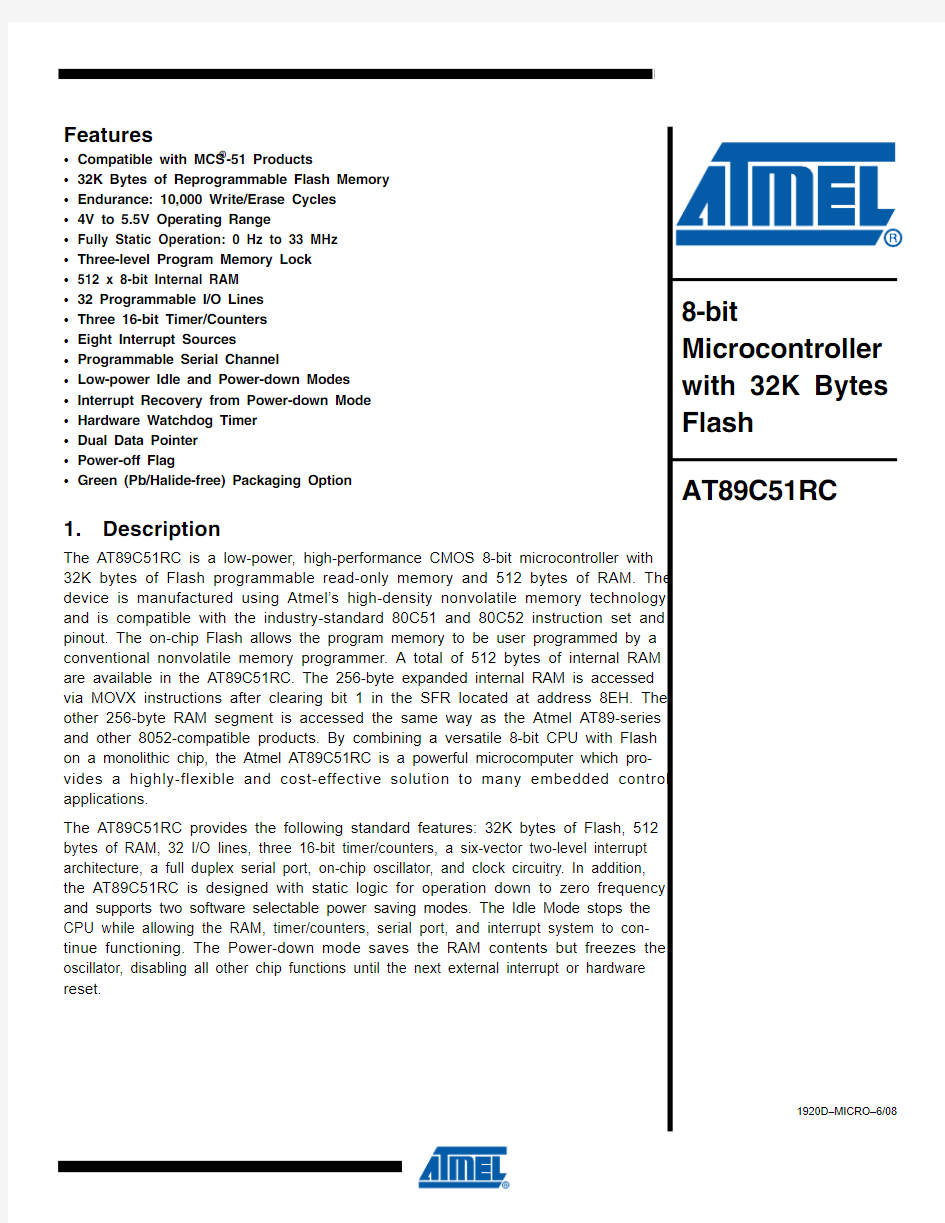AT89C51RC 中文版说明

- 1、下载文档前请自行甄别文档内容的完整性,平台不提供额外的编辑、内容补充、找答案等附加服务。
- 2、"仅部分预览"的文档,不可在线预览部分如存在完整性等问题,可反馈申请退款(可完整预览的文档不适用该条件!)。
- 3、如文档侵犯您的权益,请联系客服反馈,我们会尽快为您处理(人工客服工作时间:9:00-18:30)。
Features Array•Compatible with MCS®-51 Products
•32K Bytes of Reprogrammable Flash Memory
•Endurance: 10,000 Write/Erase Cycles
•4V to 5.5V Operating Range
•Fully Static Operation: 0 Hz to 33 MHz
•Three-level Program Memory Lock
•512 x 8-bit Internal RAM
•32 Programmable I/O Lines
•Three 16-bit Timer/Counters
•Eight Interrupt Sources
•Programmable Serial Channel
•Low-power Idle and Power-down Modes
•Interrupt Recovery from Power-down Mode
•Hardware Watchdog Timer
•Dual Data Pointer
•Power-off Flag
•Green (Pb/Halide-free) Packaging Option
1.Description
The AT89C51RC is a low-power, high-performance CMOS 8-bit microcontroller with 32K bytes of Flash programmable read-only memory and 512 bytes of RAM. The device is manufactured using Atmel’s high-density nonvolatile memory technology and is compatible with the industry-standard 80C51 and 80C52 instruction set and pinout. The on-chip Flash allows the program memory to be user programmed by a conventional nonvolatile memory programmer. A total of 512 bytes of internal RAM are available in the AT89C51RC. The 256-byte expanded internal RAM is accessed via MOVX instructions after clearing bit 1 in the SFR located at address 8EH. The other 256-byte RAM segment is accessed the same way as the Atmel AT89-series and other 8052-compatible products. By combining a versatile 8-bit CPU with Flash on a monolithic chip, the Atmel AT89C51RC is a powerful microcomputer which pro-vides a highly-flexible and cost-effective solution to many embedded control applications.
The AT89C51RC provides the following standard features: 32K bytes of Flash, 512 bytes of RAM, 32 I/O lines, three 16-bit timer/counters, a six-vector two-level interrupt architecture, a full duplex serial port, on-chip oscillator, and clock circuitry. In addition, the AT89C51RC is designed with static logic for operation down to zero frequency and supports two software selectable power saving modes. The Idle Mode stops the CPU while allowing the RAM, timer/counters, serial port, and interrupt system to con-tinue functioning. The Power-down mode saves the RAM contents but freezes the oscillator, disabling all other chip functions until the next external interrupt or hardware
reset.
2
1920D–MICRO–6/08
AT89C51RC
2.Pin Configurations
2.1
44A – 44-lead TQFP
2.244J – 44-lead PLCC
2.340P6 – 40-lead PDIP
3
1920D–MICRO–6/08
AT89C51RC
3.Block Diagram
4
1920D–MICRO–6/08
AT89C51RC
4.Pin Description
4.1
VCC
Supply voltage.
4.2GND
Ground.
4.3Port 0
Port 0 is an 8-bit open drain bi-directional I/O port. As an output port, each pin can sink eight TTL inputs. When 1s are written to port 0 pins, the pins can be used as high-impedance inputs. Port 0 can also be configured to be the multiplexed low-order address/data bus during accesses to external program and data memory. In this mode, P0 has internal pull-ups.
Port 0 also receives the code bytes during Flash programming and outputs the code bytes dur-ing program verification. External pull-ups are required during program verification.
4.4Port 1
Port 1 is an 8-bit bi-directional I/O port with internal pull-ups. The Port 1 output buffers can sink/source four TTL inputs. When 1s are written to Port 1 pins, they are pulled high by the inter-nal pull-ups and can be used as inputs. As inputs, Port 1 pins that are externally being pulled low will source current (I IL ) because of the internal pull-ups.
In addition, P1.0 and P1.1 can be configured to be the timer/counter 2 external count input (P1.0/T2) and the timer/counter 2 trigger input (P1.1/T2EX), respectively, as shown in the follow-ing table.
Port 1 also receives the low-order address bytes during Flash programming and verification.
4.5Port 2
Port 2 is an 8-bit bi-directional I/O port with internal pull-ups. The Port 2 output buffers can sink/source four TTL inputs. When 1s are written to Port 2 pins, they are pulled high by the inter-nal pull-ups and can be used as inputs. As inputs, Port 2 pins that are externally being pulled low will source current (I IL ) because of the internal pull-ups.
Port 2 emits the high-order address byte during fetches from external program memory and dur-ing accesses to external data memory that use 16-bit addresses (MOVX @ DPTR). In this application, Port 2 uses strong internal pull-ups when emitting 1s. During accesses to external data memory that use 8-bit addresses (MOVX @ RI), Port 2 emits the contents of the P2 Special Function Register.
Port 2 also receives the high-order address bits and some control signals during Flash program-ming and verification.
Port Pin Alternate Functions
P1.0T2 (external count input to Timer/Counter 2), clock-out
P1.1
T2EX (Timer/Counter 2 capture/reload trigger and direction control)
